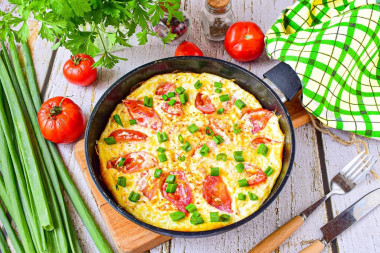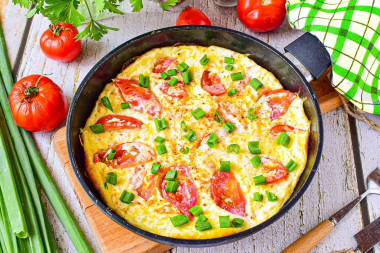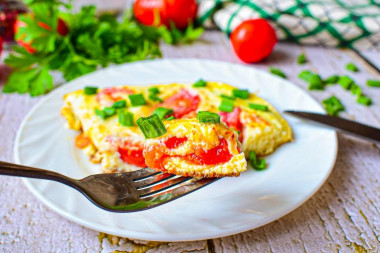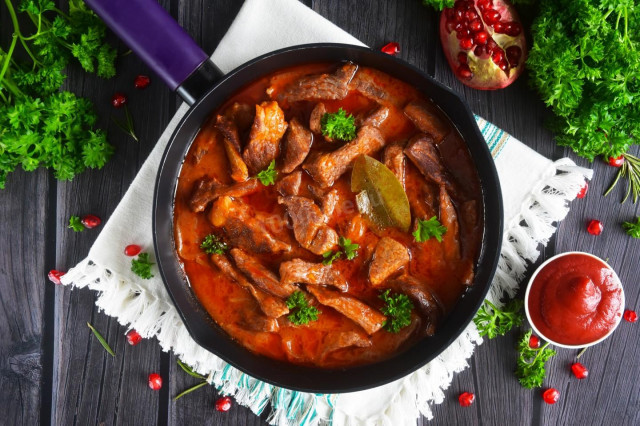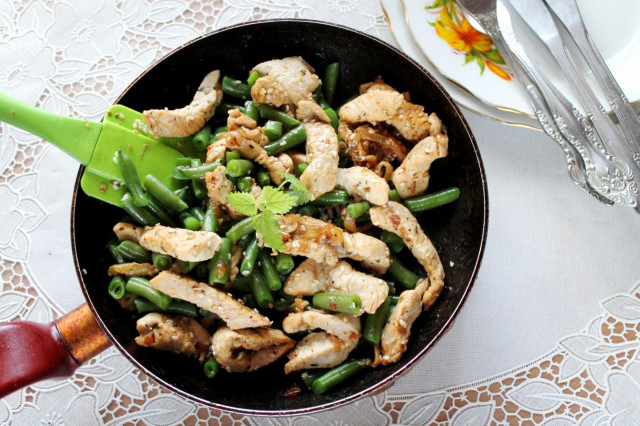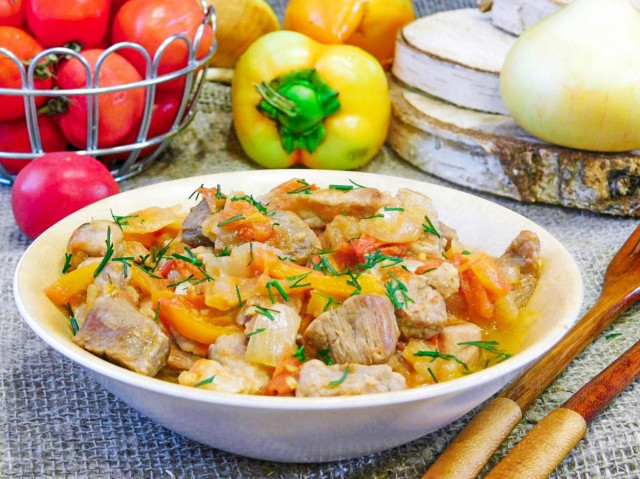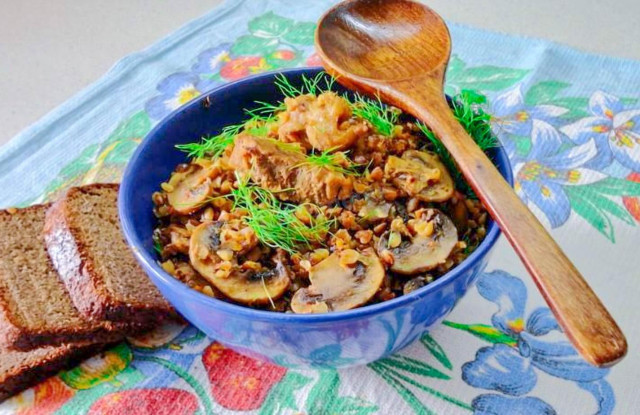Composition / ingredients
Step-by-step cooking
Step 1:
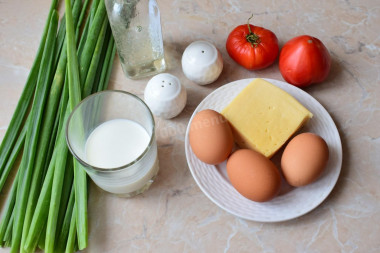
How to make an omelet with tomatoes and cheese in a frying pan? Prepare everything you need for this. The number of ingredients is very approximate. You can change any ingredient up or down, depending on your taste. You can take any cheese, the main thing is that it can be easily grated. Milk of any fat content. The higher its fat content, the more caloric the finished dish will be.
Step 2:
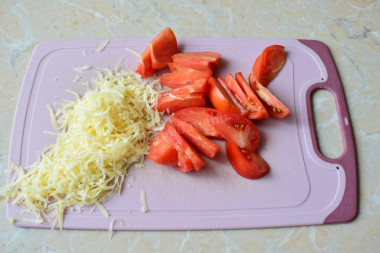
Wash tomatoes, cut in half and remove the stalk. Cut the tomatoes into slices. Grate the cheese.
Step 3:
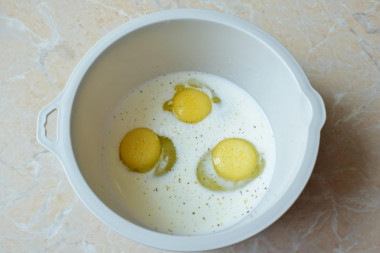
Combine eggs with milk in a separate bowl. Add a little salt and spices. Mix everything with a whisk.
Step 4:
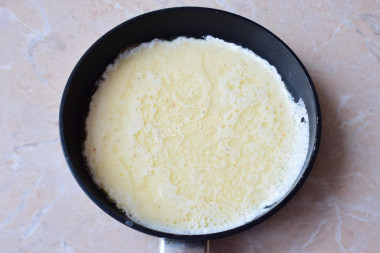
Heat the frying pan to a hot state and pour a little vegetable oil. Also, the omelet can be fried in butter. Pour the egg mixture into the pan. The bottom will immediately begin to seize.
Step 5:
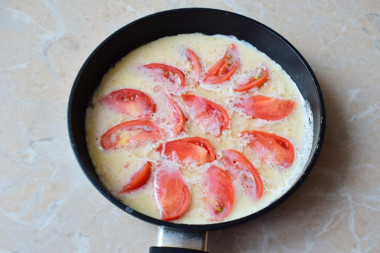
Spread the sliced tomatoes over the entire surface of the omelet. The more tomatoes, the juicier the finished omelet will be.
Step 6:
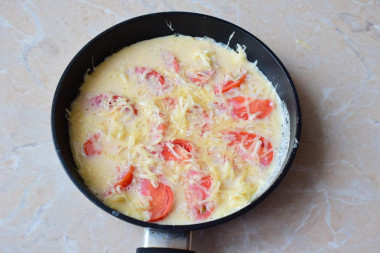
Sprinkle the omelet with grated cheese on top. Cover the pan with a lid, make a small fire and cook the omelet for 4-6 minutes. At a minimum heat, of course, it will cook longer, but it will not burn.
Step 7:
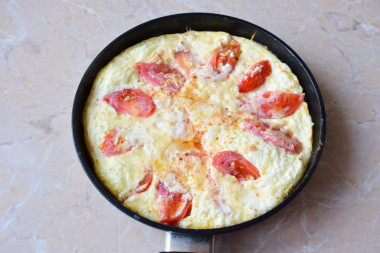
Under the lid, the omelet has time to completely bake and become airy. when the whole mass has become uniformly baked and there is no liquid left, you can remove the pan from the fire.
Step 8:
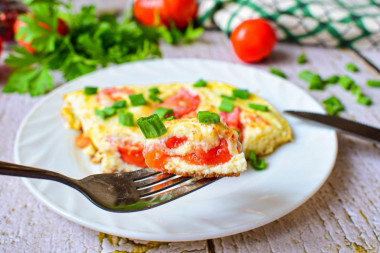
Sprinkle the finished omelet with chopped fresh herbs, place on plates and serve to the table. Enjoy your meal!
Choose juicy tomatoes, but dense. Soft fruits do not keep their shape well, in the process of slicing and cooking they will spread into a shapeless mass and spoil the appearance of the dish.
How do I know if an egg is fresh? Break it into a separate container. First of all, there should be no unpleasant smell. The protein of fresh eggs will be transparent and clean. The yolk should not spread and will be shiny, convex, homogeneous.
Be sure to wash the eggs before use, as even the seemingly clean shell may contain harmful bacteria. It is best to use food detergents and a brush.
Calorie content of the products possible in the composition of the dish
- Tomatoes - 23 kcal/100g
- Whole cow's milk - 68 kcal/100g
- Milk 3.5% fat content - 64 kcal/100g
- Milk 3.2% fat content - 60 kcal/100g
- Milk 1.5% fat content - 47 kcal/100g
- Concentrated milk 7.5% fat content - 140 kcal/100g
- Milk 2.5% fat content - 54 kcal/100g
- Chicken egg - 157 kcal/100g
- Egg white - 45 kcal/100g
- Egg powder - 542 kcal/100g
- Egg yolk - 352 kcal/100g
- Ostrich egg - 118 kcal/100g
- Dutch cheese - 352 kcal/100g
- Swiss cheese - 335 kcal/100g
- Russian cheese - 366 kcal/100g
- Kostroma cheese - 345 kcal/100g
- Yaroslavsky cheese - 361 kcal/100g
- Altai cheese 50% fat content - 356 kcal/100g
- Soviet cheese - 400 kcal/100g
- Cheese "steppe" - 362 kcal/100g
- Uglichsky cheese - 347 kcal/100g
- Poshekhonsky cheese - 350 kcal/100g
- Lambert cheese - 377 kcal/100g
- Appnzeller cheese with 50% fat content - 400 kcal/100g
- Chester cheese with 50% fat content - 363 kcal/100g
- Edamer cheese with 40% fat content - 340 kcal/100g
- Cheese with mushrooms of 50% fat content - 395 kcal/100g
- Emmental cheese with 45% fat content - 420 kcal/100g
- Gouda cheese with 45% fat content - 356 kcal/100g
- Aiadeus cheese - 364 kcal/100g
- Dom blanc cheese (semi-hard) - 360 kcal/100g
- Lo spalmino cheese - 61 kcal/100g
- Cheese "etorki" (sheep, hard) - 401 kcal/100g
- White cheese - 100 kcal/100g
- Fat yellow cheese - 260 kcal/100g
- Altai cheese - 355 kcal/100g
- Kaunas cheese - 355 kcal/100g
- Latvian cheese - 316 kcal/100g
- Limburger cheese - 327 kcal/100g
- Lithuanian cheese - 250 kcal/100g
- Lake cheese - 350 kcal/100g
- Gruyere cheese - 396 kcal/100g
- Vegetable oil - 873 kcal/100g
- Salt - 0 kcal/100g
- Spices dry - 240 kcal/100g
- Fresh frozen soup greens in a package - 41 kcal/100g
- Greenery - 41 kcal/100g


